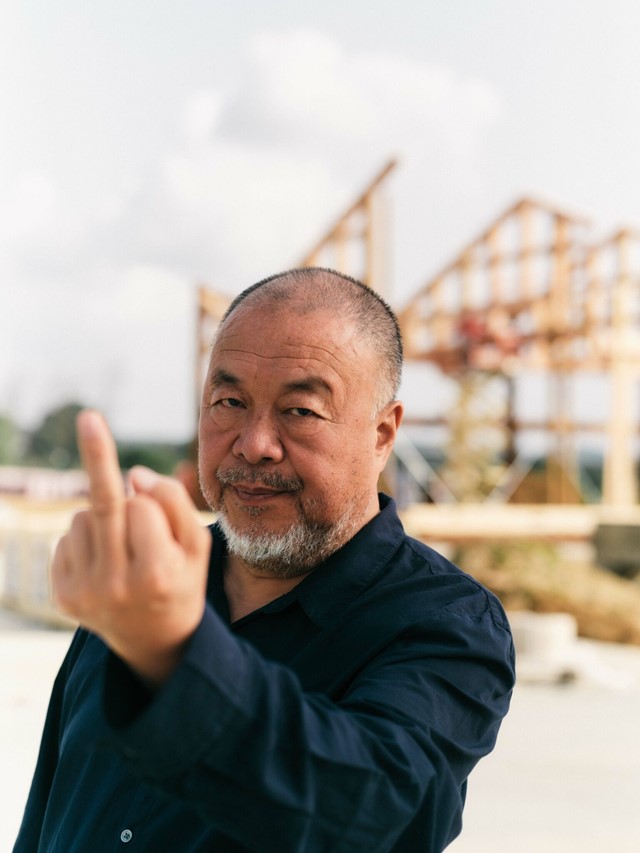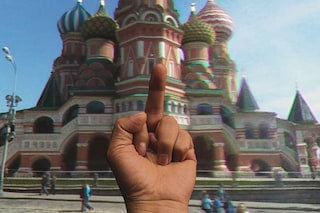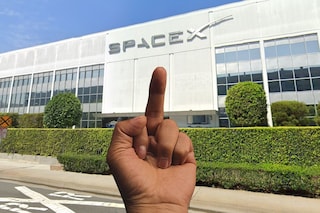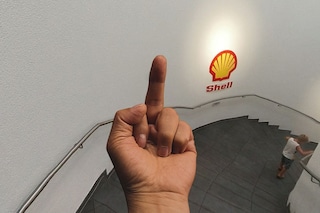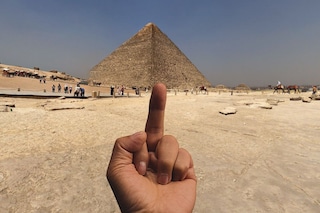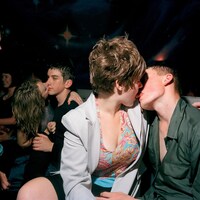The dissident artist’s latest project puts his middle finger in the public domain – here, he tells Dazed about the symbol’s potent political message
The middle finger can supposedly be traced back to ancient Greece. Not the actual appendage, of course, but the insulting gesture, which the philosopher Diogenes was said to have aimed at Demosthenes, an orator and statesman. In fact, the middle finger has been called one of the oldest insulting gestures known to humankind, stemming from its resemblance to a phallus. You could say it’s appropriate, then, that Ai Weiwei turns it toward some of the oldest institutions in the world in his provocative and long-running photo series A Study in Perspective.
The Houses of Parliament. Tiananmen Square. The White House. The Mona Lisa. The Eiffel Tower. Trump Tower. These are some of the icons condemned by Ai in A Study in Perspective. Each image is like a postcard from his travels, but overlaid with a stout middle finger. Captured on whatever camera he had to hand at the time, the pictures themselves have a simple, DIY aesthetic – despite this, or because of it, they’re some of the boldest symbols of dissent produced across the artist’s career (and, if you know Ai Weiwei, you’ll know there have been many).
It all started in Tiananmen Square in 1995, Ai tells Dazed. Having spent the 1980s and early 90s in New York, he returned to his family in Beijing in 1993, and was “disheartened” to find that there had been no real changes in the country’s political landscape in the interim. “The government maintained strict censorship and control over people’s thoughts,” he says. “Despite this, every year on June 4, the anniversary of the 1989 massacre of students in Tiananmen Square, I and my friends would go there without any specific reasons. It was my way of not forgetting it.”
In 1995, Ai took a photo with his middle finger raised, he says, “as an expression of my inner frustration”. This would become the first in the Study in Perspective series, and many more would follow, taken all around the world to convey “the stance and attitude of individual existence” in the face of economic, sociopolitical, or cultural conflicts. “Regardless of the regime, it is necessary,” he adds, “and cannot be eliminated.”
For some time, Ai has envisioned open-sourcing the gesture online, as a tool that individuals can use to express their emotional response to the world around them, on an international scale. Imagine: a sea of middle fingers rising up across the globe. Until now, though, attempts to make it a reality have fallen through. That’s where Avant Arte comes in. Ahead of an upcoming Ai Weiwei show at London’s Design Museum, the arts platform has launched an interactive online artwork in collaboration with the artist, which allows users to raise a virtual middle finger at any location in the world.
Since the project’s launch on March 16, more than 15,000 submissions have flooded in. Some highlights? A middle finger raised to a Ryanair jet, to Saint Basil’s Cathedral in Moscow’s Red Square, to racist monuments, to what appears to be someone’s own apartment. Middle fingers raised to the work of Walt Disney, Elon Musk, and Donald Trump. Business, government, and culture collide, as does the personal and the political.
Below, we talk to Ai Weiwei about what it means to share his middle finger with the world, what’s worth raising a middle finger to, and how we can continue to protest against the “intangible” institutions of the 2020s.
Choice perspectives from our collaboration with Ai Weiwei (@aiww) – Middle Finger. pic.twitter.com/4sbStF8uKx
— Avant Arte (@avant_arte) March 28, 2023
Why do you think that your middle finger has resonated with so many people around the globe?
Ai Weiwei: At the time I took the photo, it did not resonate with anyone. Being somewhat shy, I gave it a humorous title, Study of Perspective, as it was a rather understated gesture. What I never expected was that after more than three decades, people would come to realise the importance of individual expression, including acts of resistance, protest, and contempt for power. This is something that I never could have foreseen.
How have you chosen which institutions or landmarks to feature in the series over the years?
Ai Weiwei: I did not intentionally choose to make these gestures; they all occurred spontaneously. During my trip to Washington, DC, I felt the need to give the White House the middle finger, as I was acutely aware of the pressure that political capitals can exert on individuals and the way they can distort humanity. This feeling extended to many cultural institutions, such as the Guggenheim and The Metropolitan Museum of Art.
I made the gesture for a diverse range of reasons. Most often, I made these gestures out of contempt, but sometimes they were borne of boredom or other motivations that are difficult to articulate. Regardless, each gesture was related to my personal experiences.

The project with Avant Arte lets people raise a middle finger at anything they choose – do you have any advice about what kind of landmarks or institutions they should focus their anger toward?
Ai Weiwei: In my view, putting up a middle finger is not always a sign of anger. Rather, it can serve as a form of direction that includes different shades of criticism and condemnation, or it can simply express an individual’s emotions. When people use their actions to express their inner thoughts, even if those thoughts are not fully developed or are subject to doubt, they represent the most fundamental motivation for freedom of speech and expression. This value must be completed through a tangible form. Today, we are effectively making a form of language publicly available, which provides people with the opportunity to express their inner emotions or intentions.
I believe that the direction of the middle finger can be anything, so long as it points to a sense of pressure that restrains or oppresses an individual’s power. In this sense, any direction can be more than reasonable.
The project features many physical monuments to old world power structures. How can we continue such a protest against the new and emerging power structures we see today, which are increasingly online and not rooted in physical structures?
Ai Weiwei: We can regard the middle finger as a personal monument that declares our existence to the world and conveys a certain meaning or expression in protest at any time and in any place. Today, power does not necessarily manifest itself as a tangible force, but rather, it can be in the form of an ideology, cultural trends, or prevailing public opinion. When we can raise our middle finger, don’t forget to do so unhesitatingly.
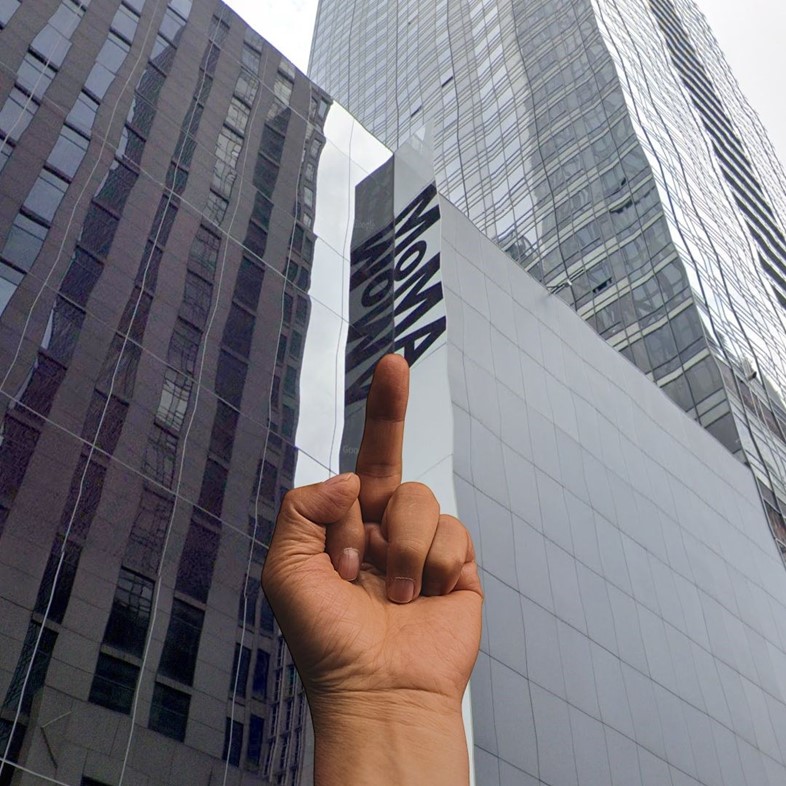
You have often been called an artist and an activist. Where do you draw the line between the two?
Ai Weiwei: I am an artistic activist and an activist artist. The line between the two is only about which one is more at the front, and which one is more at the back.
What can we expect from your upcoming Design Museum exhibition, and how does it differ from your past exhibitions in its focus on design and architecture?
Ai Weiwei: It marks the first time that I have employed my long-term efforts in various fields, including art, architecture, film, and more, to redefine the concept of design. The concept of design has existed long before I fully realised that I was an artist, and even if I were not an artist, all my efforts would still be aimed at defining my personal actions and surroundings. This attempt of defining through my own language is essentially a process of design. I am thus simply attempting to expand upon the fundamental meaning of design.
My greatest expectation for the exhibition is that visitors will feel inspired to raise their middle finger in response to my work.
Ai Weiwei: Making Sense opens at the Design Museum on April 7. On March 30, a print sale featuring new works by Ai Weiwei will be launched via Avant Arte, with proceeds supporting the Design Museum.
